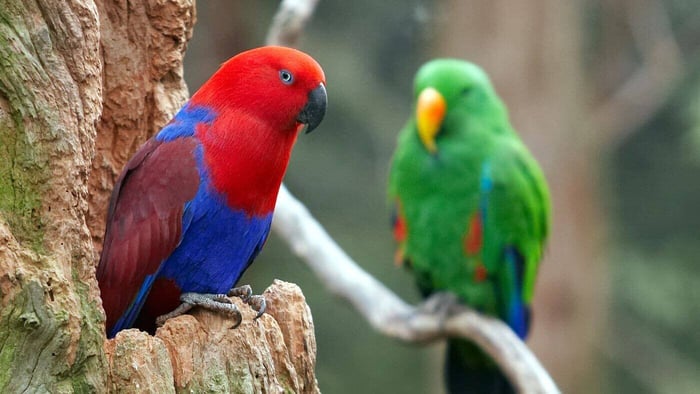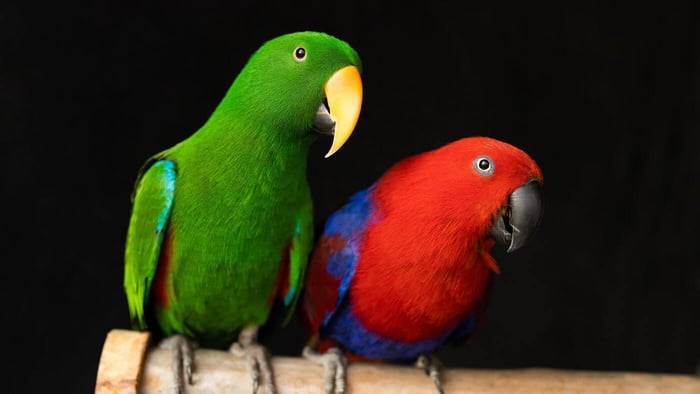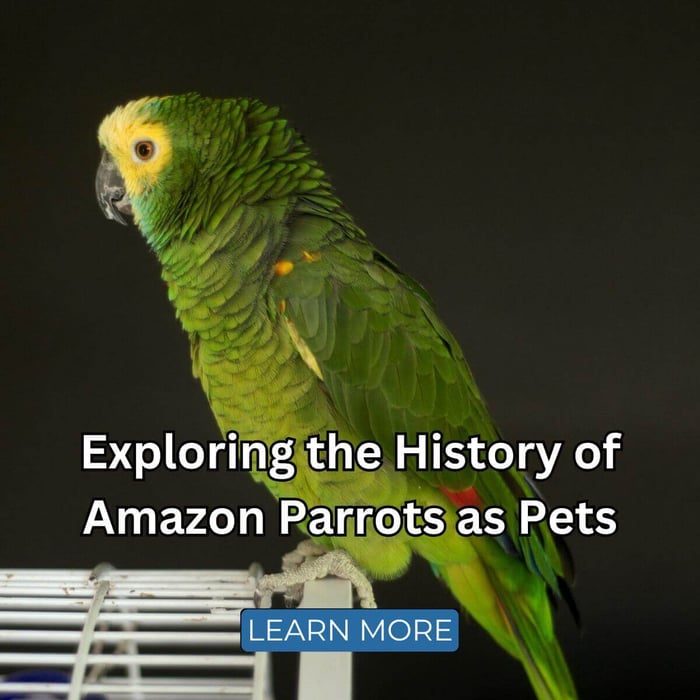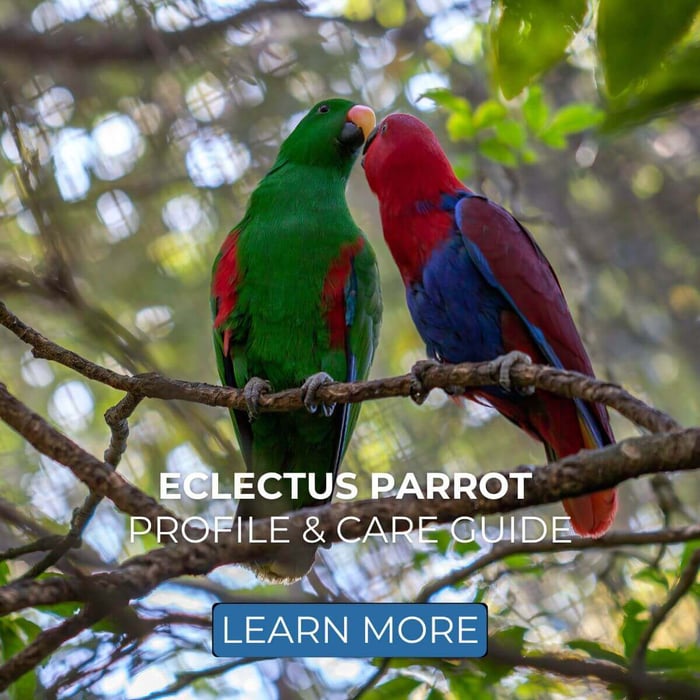Eclectus Parrots as Pets: Tracing Their Path from Wild to Domestic Life
Every year on 18th April, we celebrate Eclectus Day, a day dedicated to one of nature's most fascinating parrots. Known for their stunning colours and engaging personalities, Eclectus parrots as pets have captured human hearts for generations. But how exactly did these extraordinary birds transition from exotic rainforest creatures to beloved household companions? Let's explore their fascinating journey and understand why Eclectus parrots as pets continue to be so cherished today.
Origins of the Eclectus Parrots
Eclectus parrots (Eclectus roratus) originate from the dense rainforests of New Guinea, the Solomon Islands, northeastern Australia, and nearby archipelagos. Historically, their vibrant and strikingly different appearances between males and females (known as sexual dimorphism) once led early European naturalists to mistakenly classify them as separate species. Male Eclectus parrots are emerald green with bright orange beaks, while females feature vivid red and blue feathers with black beaks. This unusual distinction initially baffled bird enthusiasts and scientists alike.
The Eclectus parrot's natural habitat is characterised by lush foliage, tall trees, and dense canopies, making them masters of camouflage despite their vivid colours. The abundant fruit-bearing trees within their environment influenced their diet, predominantly consisting of fruits, nuts, seeds, and blossoms. Their unique digestive system has evolved specifically to process high-fibre fruits and plant material, making their dietary requirements distinctive among parrots.
Historical Encounters and Classification
The European discovery of Eclectus parrots dates back to early exploratory missions in the 18th and 19th centuries, as sailors and naturalists explored the remote islands of the Pacific and surrounding regions. Early European explorers were captivated by the striking beauty and unique characteristics of these parrots, leading to their introduction to Europe. Early naturalists, upon observing the marked differences in male and female plumage, incorrectly identified them as two separate species. It wasn't until detailed field studies and observations were conducted that the scientific community recognised the male and female as belonging to a single, sexually dimorphic species.
Eclectus Parrots Enter Human Homes
The journey of Eclectus parrots as pets began in earnest in the late 19th and early 20th centuries when explorers returned from expeditions bearing these captivating birds. Early bird collectors in Europe and America quickly noted the species' remarkable intelligence and their impressive ability to mimic human speech and sounds. Eclectus parrots rapidly gained popularity not only for their beauty but also for their calm, gentle, and less noisy temperament compared to other parrot species, making them ideal companions in household environments.
Throughout the 20th century, eclectus parrots increasingly became symbols of exotic luxury, appearing in art, literature, and popular culture. Wealthy families in Victorian England often displayed these birds in elaborate aviaries, symbolising wealth and refined taste. This trend gradually permeated into middle-class homes as the bird trade expanded, increasing their accessibility and popularity globally.
Varieties of Eclectus Parrots as Pets
Eclectus parrots aren't uniform; several distinct subspecies have captivated parrot lovers, each with unique traits:
- Solomon Island Eclectus (E. r. solomonensis): The most common in captivity, smaller in size, and particularly colourful. Their size and sociable nature make them ideal for families and apartment living.
- Papuan Eclectus (E. r. polychloros): Native to New Guinea, larger birds with slightly muted colouration in males. Known for being affectionate but more independent compared to their Solomon Island counterparts.
- Vosmaeri Eclectus (E. r. vosmaeri): Known for females' striking deep-red plumage and males' lighter green feathers. These birds are highly sought after for their vivid beauty and tend to have outgoing personalities.
- Australian Eclectus (E. r. MacGillivray): The largest variety, native to Australia's Cape York Peninsula, often distinguished by size and slightly varied feather shades. They are admired for their majestic appearance and gentle disposition.
Each subspecies brings unique attributes, adding to the Eclectus parrot's overall charm as a companion bird.
Popularity and Famous Eclectus Stories
Eclectus parrots as pets have become increasingly popular due to their manageable size, affectionate yet independent nature, and remarkable speaking capabilities. Owners frequently highlight their Eclectus parrots' playful personalities, charming quirks, and clever antics. These parrots easily become cherished family members, forming deep bonds with their human caretakers.
Many Eclectus parrots have also gained fame beyond their households. For instance, Lucy, an Eclectus parrot at Flamingo Gardens in Florida, has become a local celebrity, known for charming visitors with her outgoing personality and amusing antics. Stories like Lucy's demonstrate the charismatic appeal of these birds and their ability to captivate and engage human audiences of all ages.
In popular culture, Eclectus parrots have been featured in various films, documentaries, and television shows, reinforcing their position as beloved and fascinating companions. Their natural ability to mimic human voices often leads to humorous and heartwarming anecdotes, making them perfect pets for families who enjoy lively interactions.
Caring for Eclectus Parrots as Pets
Owning an Eclectus parrot requires careful consideration and responsible care. These birds thrive on diets abundant in fresh fruits, vegetables, and specially formulated pellets. Adequate nutrition is vital to maintain their vibrant feathers and overall health. Mental stimulation through interactive toys, puzzles, and regular social interaction is equally important to prevent boredom and stress.
Potential owners must also understand the natural independent streak of Eclectus parrots. While affectionate, they prefer gentle, respectful interaction and may not appreciate overly invasive handling. Creating a safe and enriching environment is critical for their well-being. Many experienced Eclectus owners advocate for spacious cages, regular out-of-cage time, and structured social activities to foster a balanced temperament.
Eclectus Parrots: Conservation and Ethical Pet Ownership
As popularity has risen, so too have concerns about the conservation of Eclectus parrots in the wild. Illegal capture and habitat destruction pose significant threats. Ethical pet ownership involves ensuring these parrots are responsibly sourced, typically from reputable breeders or rescue organisations dedicated to parrot welfare and conservation.
Eclectus Day provides an excellent opportunity to highlight responsible ownership and conservation efforts. Bird enthusiasts and conservationists use this day to educate prospective and current owners about sustainable practices and how they can contribute to protecting these extraordinary birds in their natural habitats.
Conclusion
The story of Eclectus parrots as pets is a fascinating blend of historical intrigue, natural wonder, and human-animal companionship. As we mark another Eclectus Day, let us reflect on the journey of these remarkable birds, from rainforest canopies to becoming cherished companions in our homes, enriching our lives with their colour, charm, and intelligence. Through responsible ownership and conservation awareness, we can ensure that the beauty and charisma of Eclectus parrots continue to brighten our world for generations to come.
FAQs
What makes male and female Eclectus parrots look so different?
Male Eclectus parrots are bright green with orange beaks, while females are red and blue with black beaks. This striking difference is due to sexual dimorphism, where the two sexes have visibly different colours and features.
Are Eclectus parrots good pets for beginners?
Eclectus parrots can make wonderful pets, even for dedicated beginners, but they do require time, patience, and proper care. Their specific dietary needs and preference for gentle interaction make them best suited to owners willing to learn and adapt.
What do Eclectus parrots eat?
They need a diet rich in fresh fruits, vegetables, and specially formulated pellets. Their digestive system is designed for high-fibre, plant-based foods - so avoid fatty seeds and sugary treats.
Can Eclectus parrots talk?
Yes! Eclectus parrots are known for their impressive talking ability. With regular interaction and training, many can mimic human speech and sounds very clearly.
Where can I get an Eclectus parrot responsibly?
Always choose a reputable breeder or a parrot rescue organisation. Ethical sourcing is important to avoid supporting illegal wildlife trade and to promote the welfare of these beautiful birds.




